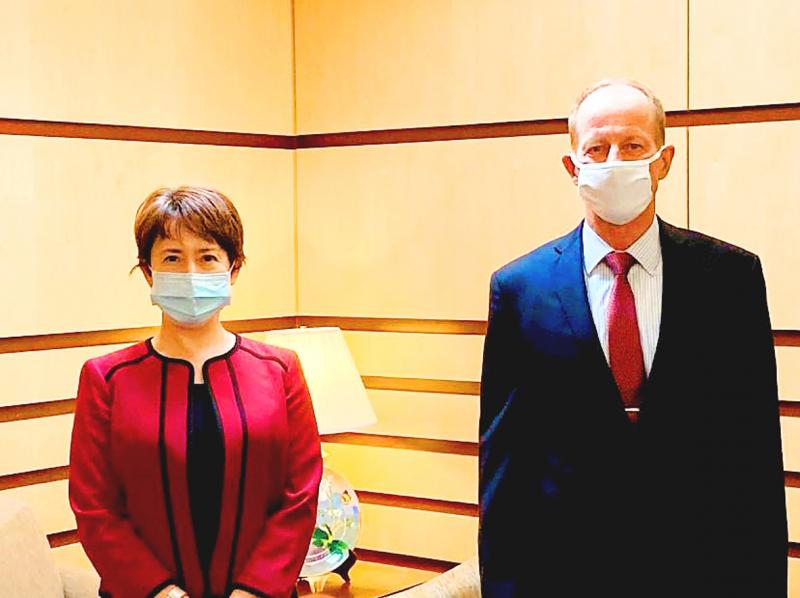Representative to the US Hsiao Bi-khim (蕭美琴) on Monday met with US Assistant Secretary of State for East Asian and Pacific Affairs David Stilwell at the US Department of State in Washington, and pledged to enhance bilateral ties.
Before departing to Washington, Hsiao told local media that she would use “war cat” diplomacy — as cats are smart, agile and flexible — to secure a space for survival amid a fast-changing global situation.
She took her four cats with her to the US.

Photo: screen grab from Facebook page of the Taipei Economic and Cultural Representative Office in Washington
The Taipei Economic and Cultural Representative Office (TECRO) in Washington yesterday posted a photograph showing Hsiao meeting Stilwell on its Facebook and Twitter pages, which are titled “Taiwan in the US.”
The office wrote that Hsiao looks forward to working with Stilwell and his team at the bureau to develop an “even closer Taiwan-US partnership.”
“Taiwan is committed to expanding our economic, security, cultural & educational ties with the US in the years ahead,” the office wrote.
During their meeting, Hsiao and Stilwell exchanged opinions on improving bilateral ties, Ministry of Foreign Affairs spokeswoman Joanne Ou (歐江安) said yesterday.
Asked if the meeting took place at the US Department of State, Ou said that, based on a tacit understanding between both sides, the ministry would refrain from disclosing the content of their conversation or other details about the meeting.
Judging by the photograph’s background — which was possibly the same place where Stilwell met then-outgoing representative to the US Stanley Kao (高碩泰) on July 8 — Hsiao and Stilwell might have met at the US Department of State, the US Taiwan Watch group wrote on Facebook yesterday.
Just a few years ago, Taiwan’s diplomats could rarely appear together with US administrative officials publicly, and were forbidden from entering the US Department of State by some of the US’ internal regulations, it wrote.
Later yesterday, Hsiao wrote on Facebook that Stilwell had received her at the US Department of State.
“Although we practiced social distancing, we wore, under our masks, smiles of pleasure for the meeting,” she wrote in Chinese.
“Taiwan is a force for good and a trustworthy partner for the world, and many important issues between Taiwan and the US are waiting to be boosted,” she added.

Taiwan is to commence mass production of the Tien Kung (天弓, “Sky Bow”) III, IV and V missiles by the second quarter of this year if the legislature approves the government’s NT$1.25 trillion (US$39.78 billion) special defense budget, an official said yesterday. Commenting on condition of anonymity, a defense official with knowledge of the matter said that the advanced systems are expected to provide crucial capabilities against ballistic and cruise missiles for the proposed “T-Dome,” an advanced, multi-layered air defense network. The Tien Kung III is an air defense missile with a maximum interception altitude of 35km. The Tien Kung IV and V

The disruption of 941 flights in and out of Taiwan due to China’s large-scale military exercises was no accident, but rather the result of a “quasi-blockade” used to simulate creating the air and sea routes needed for an amphibious landing, a military expert said. The disruptions occurred on Tuesday and lasted about 10 hours as China conducted live-fire drills in the Taiwan Strait. The Civil Aviation Administration (CAA) said the exercises affected 857 international flights and 84 domestic flights, affecting more than 100,000 travelers. Su Tzu-yun (蘇紫雲), a research fellow at the government-sponsored Institute for National Defense and Security Research, said the air

A strong continental cold air mass is to bring pollutants to Taiwan from tomorrow, the Ministry of Environment said today, as it issued an “orange” air quality alert for most of the country. All of Taiwan except for Hualien and Taitung counties is to be under an “orange” air quality alert tomorrow, indicating air quality that is unhealthy for sensitive groups. In China, areas from Shandong to Shanghai have been enveloped in haze since Saturday, the ministry said in a news release. Yesterday, hourly concentrations of PM2.5 in these areas ranged from 65 to 160 micrograms per cubic meter (mg/m³), and pollutants were

Taiwan’s armed forces have established response protocols for a wide range of sudden contingencies, including the “Wan Chun Plan” to protect the head of state, the Ministry of Defense (MND) said today. After US President Donald Trump on Saturday launched a series of airstrikes in Venezuela and kidnapped Venezuelan President Nicolas Maduro, concerns have been raised as to whether China would launch a similar “decapitation strike” on Taiwan. The armed forces regularly coordinate with relevant agencies and practice drills to ensure preparedness for a wide range of scenarios, Vice Minister of National Defense Hsu Szu-chien (徐斯儉) told reporters before a